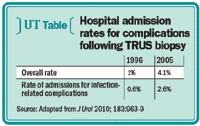Article
Post-prostate biopsy infection: Incidence and preventive steps
This article discusses the rising incidence of both fluoroquinolone resistance and serious post-biopsy infectious complications, and offers recommended preventive measures, including a new algorithm incorporating targeted antimicrobial prophylaxis based on rectal swab cultures.


This article discusses the rising incidence of both fluoroquinolone resistance and serious post-biopsy infectious complications, and offers recommended preventive measures, including a new algorithm incorporating targeted antimicrobial prophylaxis based on rectal swab cultures.
Although the use of prophylactic peri-procedural antimicrobials has reduced the incidence of symptomatic infectious complications, the specific antimicrobial to be used and the duration of treatment are not uniformly agreed upon. Fluoroquinolones are widely used due to their oral administration, minimal side effect profile, broad-spectrum coverage of both colorectal and urinary flora, high concentration within prostatic tissue, and long-lasting urinary bactericidal activity. Additionally, there is controversy in the literature regarding the use of pre-procedure bowel preps to prevent infectious complications.
Given their wide usage as prophylaxis during urologic procedures and as treatment for urologic infections, resistance to fluoroquinolones is beginning to emerge. Recent reports have demonstrated increasing rates of fluoroquinolone-resistant symptomatic urinary tract infections following prostate biopsy (J Urol 2008; 179:952-5; J Urol 2011; 185[suppl]:e574, abs. 1434). Additionally, there have been numerous case reports of extended-spectrum beta-lactamase (ESBL)-producing bacteria causing post-prostate biopsy febrile urinary tract infections and sepsis. ESBL are enzymes that mediate resistance to extended-spectrum (third-generation) cephalosporins (eg, ceftazidime [Fortaz, Tazicef], cefotaxime [Claforan], and ceftriaxone [Rocephin]) and monobactams (eg, aztreonam [Azactam]) but do not affect cephamycins (eg, cefoxitin [Mefoxin] and cefotetan) or carbapenems (eg, meropenem [Merrem], imipenem/cilastatin [Primaxin] and ertapenem [INVanz]) (Urology 2006; 68:1169-74).
ESBL resistance is usually encoded on large plasmids that often carry genes conferring resistance to other nonrelated antimicrobials (including fluoroquinolones, trimethoprim-sulfamethoxazole [Bactrim, Septra DS], penicillins, and aminoglycosides), leaving few therapeutic options. Ena et al demonstrated a significant increase in the proportion of ESBL-producing Escherichia coli isolates from urine samples collected in their hospital, from 0.2% to 5.52% between 1999 and 2004 (Urology 2006; 68:1169-74). Risk factors for the development of fluoroquinolone-resistant or ESBL-associated sepsis include recent use of third-generation cephalosporins, fluoroquinolones, or aminoglycosides; relationships to health care workers; indwelling catheters; and history of urinary tract disorders (eg, retention, nephrolithiasis, etc.) (Am J Infect Control 2005; 33:326-32; Urology 2006; 68:1169-74).






